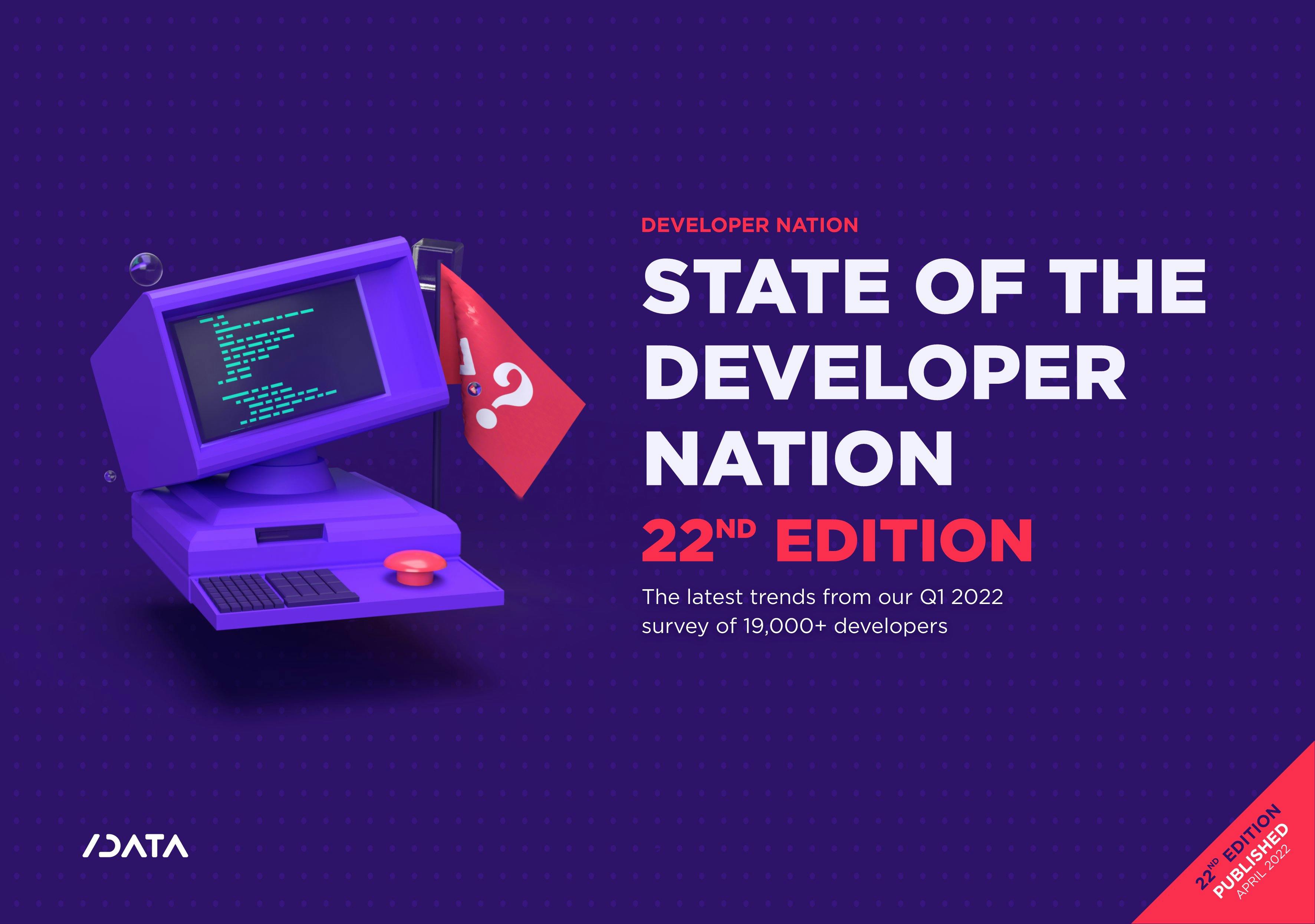
May 04, 2022
State of the Developer Nation 22nd Edition - Q1 2022
SlashData's Developer Nation is the leading research programme on mobile, desktop, industrial IoT, consumer electronics, embedded, third-party app ecosystems, cloud, web, game, AR/VR and machine learning developers, as well as data scientists, tracking the developer experience across platforms, revenues, apps, languages, tools, APIs, segments, and regions.
The 22nd edition of the Developer Nation global survey wave ran from December 2021 to February 2022 and reached more than 20,000 developers in 166 countries. This research report delves into key developer trends for Q1 2022 and beyond.
The report focuses on six major themes - each with its own visualisations - showing how the data lends insight into the developer community.
- Language communities - an update: Programming languages are often the kernels of strong communities and the subject of opinionated debate. In this chapter, we provide updated estimates of the number of active software developers using each of the major programming languages, across the globe and across all kinds of programmers.
- Understanding developer personalities: Personality theories provide a blueprint for understanding why people behave the way they do. In the
latest edition of our Developer Nation survey, we incorporated a measure of the widely accepted ‘Big Five’ personality dimensions in order to better understand the personality traits of software developers. In this chapter, we segment the developer population into a set of distinct personality types and we discuss some key differences between these segments. - Who is using low-code/no-code tools?: Low-code/no-code (LCNC) tools provide a visual approach to software development, abstracting and
automating parts of the application development process. In this chapter, we investigate the extent to which developers are using LCNC tools,
showing differences according to professional status, geographical regions, and experience levels. - Spotlight on China and the rest of East Asia: This chapter focusses on some of the key differences between developers located in East Asia, including the Greater China region, and the rest of the world. Understanding these differences provides valuable insights that can help shape the strategy for developer engagement programmes.
- How developers generate revenues: How businesses and developers as individuals make money from software projects is one of the most important decisions they have to make. Of all the business models and strategies available, companies and freelancers need to pick the ones that best match their market and goals. In this chapter, we explore the revenue models used by professional developers and how these vary across industry verticals and companies of different sizes.
- Emerging technologies: Many high-profile emerging technologies are slated to change the world, including self-driving cars and the Metaverse. However, there are many more outside of the spotlight, such as AI-assisted programming, that will also have profound and far-reaching implications. In the last chapter, we explore how developers are involved with a range of emerging technologies.
Methodology
The 22nd edition of the Developer Nation survey reached 20,000+ respondents from 166 countries around the world. As such, the Developer Nation series of surveys continues to be the most global independent research on mobile, desktop, industrial IoT, consumer electronics, embedded, third-party app ecosystems, cloud, web, game, augmented and virtual reality, and machine learning developers and data scientists combined, ever conducted. The report is based on a large-scale, online developer survey designed, produced, and carried out by SlashData over a period of nine weeks between June and August 2021.
Respondents to the online survey came from 166 countries, including major app and machine learning development hotspots such as the US, China, India, Israel, the UK, and Russia, even stretching all the way to Kenya, Brazil, and Jordan. The geographic reach of this survey is truly reflective of the global scale of the developer economy. The online survey was translated into eight languages in addition to English, namely simplified Chinese, traditional Chinese, Spanish, Portuguese, Vietnamese, Russian, Japanese, and Korean, and was promoted by nearly 80 leading community and media partners within the software development industry.
Our respondents came from a broad age spectrum, from young coders who are under 18 to the seasoned ones over 55.. Respondents were asked which types of projects they are involved in out of the 13 under study, namely web apps / SaaS, mobile apps, desktop apps, backend services, augmented reality, virtual reality, games, data science, machine learning / artificial intelligence, industrial IoT, consumer electronics devices, embedded software, and apps/extensions for third-party app ecosystems. They also told us if they are into their areas of involvement as professionals, hobbyists, or students - or as any combination of these - and how many years of experience they have in each.
To eliminate the effect of regional sampling biases, we weighted the regional distribution across nine regions by a factor that was determined by the regional distribution and growth trends identified in our Developer Nation research. Each of the separate branches: mobile, desktop, Industrial IoT, consumer electronics, embedded software, third-party app ecosystems, cloud, web, games, augmented and virtual reality, and data science and machine learning were weighted independently and then combined.
To minimise other important sampling biases across our outreach channels, we weighted the responses to derive a representative distribution for technologies used and developer segments. Using ensemble modelling methods, we derived a weighted distribution based on data from independent, representative channels, excluding the channels of our research partners, to eliminate sampling bias due to respondents who were recruited via these channels. Again, this was performed separately for each of mobile, industrial IoT, consumer electronics, embedded software, third-party app ecosystems, desktop, cloud, web, games, augmented and virtual reality, and data science and machine learning.
For more information on our methodology please visit https://www.slashdata.co/methodology.
Contact us
Swan Buildings (1st floor)20 Swan StreetManchester, M4 5JW+441612400603community@developernation.net